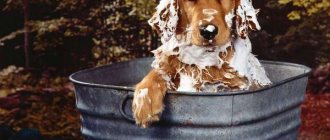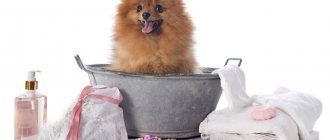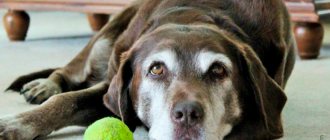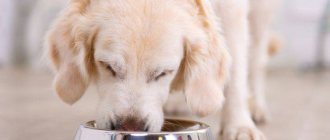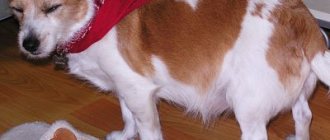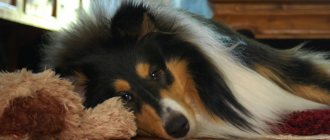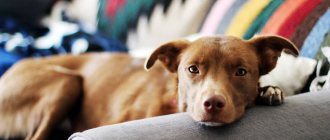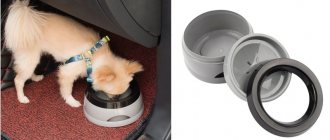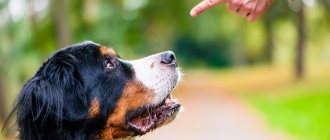Service dog breeding appeared a long time ago. The reason for its development in the world and in the country was the human need for animals that could be entrusted with certain work functions. And it's not just about doing physical work.
They found the use of qualities that are inherent specifically to dogs, namely: strength, endurance, courage and devotion, a keen sense of smell, and intelligence. This is what service dogs became. In everyday life, the need for guide dogs, guard dogs, and shepherds is growing. The dogs work as assistants in searching for gas and ore; they are trained to search for drugs and to detect victims of earthquakes and other natural disasters.
Keeping a service dog
Almost all service dogs require general and service training. Owners should be aware that a service dog will not receive breeding class unless it has a training certificate. Any large dog needs vitamins for service dogs WOLMAR to maintain its physical shape: long walks, free walking in open space without a leash. A complete diet plays an important role in maintenance. In general, a service dog, unlike a decorative little “fashionable toy,” requires labor-intensive, loving care.
When keeping dogs in groups, for example, in kennels, strict control is exercised over feeding, care, hygiene measures aimed at preserving the performance of service dogs, as well as over the implementation of breeding work.
Place where service dogs are kept
Proper housing conditions for dogs are of great importance for preserving their health and maintaining their performance, since most of the time they are in one place of accommodation - resting, restoring the strength expended in service. Due to the impossibility of free movement, dogs in unfavorable conditions can get sick. On the contrary, proper placement of dogs has a beneficial effect on their body. Therefore, premises for service dogs must meet hygienic requirements regarding both heat, moisture, air composition, and the required footage. Diseases and recommendations for the German Shepherd
It is better to locate the nursery on a hill, away from residential premises, livestock farms, and industries with hazardous waste. The nursery includes enclosures, a kitchen, a training area, premises for personnel, etc. The territory of the nursery is fenced with a solid high fence. Enclosures made of wood, brick or stone should be warm and dry, but unheated. The floor in cabins and enclosures should be easy to clean, quick-drying, but non-slip, with a slight slope. The entrance door to the cabin in the lower part is equipped with a manhole, which in winter is covered with a curtain made of dense material. The roof is made sloping back with canopies at the front and rear. Light in the room, both natural and artificial, is a must. And not only when there are people there. Dogs themselves definitely need light, since it is a necessary condition for all metabolic processes in the animal’s body.
The paddock attached to the cabin is an open room measuring 2x3 m with a waterproof floor and a front wall made of metal mesh. Concrete ditches are installed along the enclosure for sewage, melt and rainwater with a slope for random drainage. In front of the enclosures, a few meters from them, a dog tether is installed - wooden posts about 40 cm high, dug into the ground at a distance of 3 meters from each other, with a small platform at the top. During cleaning, the dogs' front paws are placed on these pads. A rack is equipped inside the cabin, and in cold areas a collapsible booth is installed in accordance with the size of the dog.
Enclosures must be cleaned daily, thoroughly cleaned once a week, and disinfected once a month. In summer, it is advisable to dry the booths in the sun. It is advisable to remove feces from the floor twice a day or more often so that the dog’s sense of smell is not dulled by the smell. In winter, the booths must be insulated. If straw is used, it should be changed once a week. For each enclosure, individual equipment is used - a dustpan, a broom, a bucket.
To accommodate both sick and newly admitted dogs, an isolator is needed that can accommodate 1/10 of the dog population. It should be located no closer than 250 m from the main buildings behind a solid two-meter fence.
Features of the booth arrangement
Don’t get carried away and build a whole palace for your dog - the animal will not appreciate your efforts and will feel uncomfortable. A good booth is one that is made of wood, consists of a cold vestibule and an insulated interior, is not blown through, and has a pitched roof.
The design diagram looks like this:
The area is determined by the size of the dog. There should be enough space inside to turn around and sleep in a position with legs outstretched. For areas with cold winters, you should not make the kennel too spacious, otherwise the dog will freeze.
- The height of the booth
= the height of the dog at the withers + the thickness of the bedding + 10–15 cm. - Depth
= distance from the withers to the tips of the front legs + 10–15 cm. - Width
= width of the berth and vestibule. - Sleeping place
= length of the dog from the nose to the base of the tail + 10–15 cm. - Entrance height
= height at withers + 5–9 cm. - Entry width
= dog's chest width + 5–8 cm.
Read also: Clematis Sylvia denny description
A simpler option without dividing into two parts is calculated as follows:
The walls are made of coniferous wood - it has disinfecting properties and creates an optimal microclimate. Mineral wool and polystyrene foam are used for insulation. The floor is raised above the ground by 10–15 cm.
The roof is ideally removable. This allows:
- easy to clean inside the booth,
- without any problems getting an animal for medical care.
A shed roof is preferable because dogs often like to sit or lie on it while watching the area. It should have a slight slope towards the rear wall. If there is no flooring above the booth, the roof should be covered with soft, sound-damping material. Then the pet will be comfortable during rain or hail.
The entrance is made from the side along the long side. In winter, it is hung with thick burlap, felt, and tapestry. Straw or special bedding is placed on the floor.
Caring for a Service Dog
Just like service dogs kept in an apartment or private home, group-housed pets should receive daily hygiene procedures such as care for the eyes, teeth, ears, paw pads and claws. In the same way, they need to be combed and their coat taken care of. All procedures are performed by a dog handler attached to the dog. — Eye treatment. This important organ in a dog must be healthy and clean. It is very important not to miss the onset of eye inflammation. Eyes should be washed daily, especially after exercising, walking or working in smoke or gas conditions. Diseases and recommendations for Doberman
— Dental care. It is necessary to examine the oral cavity once a week. Make sure that nothing gets stuck between the teeth, so that tartar does not form. For prevention, the dog needs to massage its gums and brush its teeth. — Ear treatment. Ears should be washed or wiped with furacillin solution or other disinfectant solutions once a week. If your ears are not very dirty, you can use cotton swabs with oil.
Blepharitis in dogs
Brachycephalic syndrome in dogs
Bronchopneumonia in small breed dogs
Bursitis in dogs
The dog is limping
— Paw care. Regular inspection of the paws, claws, pads, and interdigital spaces of the sponsored dog is also the responsibility of the dog handler. Be sure to remove all stuck foreign bodies that can cause inflammation. In summer, fuel oil and tar may remain on the paws; in winter, reagents for treating roads. Therefore, after a walk you need to wash and treat your paws. We must not forget about regular nail care - trimming, treatment.
- Grooming. Very important procedures are daily combing, washing, cutting, trimming, since the coat is an indicator of the dog’s condition. Daily combing, in addition to a well-groomed appearance, makes it possible to get rid of parasites, debris, dead hair, and it is also a massage of the skin that improves blood circulation. As for washing, it should be done no more than once every 2 months, with a small amount of shampoo, in water with a temperature of about 36 degrees. And if the dog should be washed as rarely as possible, then it can bathe often, since this hardens the body and develops the chest, which is important for a service dog. It is best to bathe in the morning before feeding.
— Care for the olfactory organs. The nose needs to be checked not only for the presence of various secretions, but also to monitor whether the animal’s nose is cold and wet. A warm and dry nose indicates that the dog is unwell. If the nose is wet and cold, the dog is healthy.
Walking the dog
The dog needs to be walked at least twice a day. The purpose of this is not only to satisfy its natural needs, but also an opportunity for the animal to frolic, run, and warm up. For such long walks and regular exercises, dogs are taken to specially designated areas with grass. For dog walking, it is best to organize a so-called two-field walking system, when one field is used for its intended purpose, and the second “rests” for a month, which allows you to naturally deactivate pathogens of dangerous diseases and worm eggs.
Sufficient time should be allocated for walking, since an adult dog empties its bladder in several stages with breaks. It is especially important to satisfy natural needs before training, otherwise the dog will worry or do its “business” right on the training ground. Diseases and recommendations for a bulldog In order for your dog to get used to regular toileting, you need to adhere to a feeding and walking schedule. Dogs that have a feeding schedule are fairly predictable, and with the appropriate feeding routine, a regular routine will develop when going to the “toilet.”
Feeding
The diet consists of observing the quantity and frequency of feedings, compliance of the norms of food eaten by the dog with the state of its health, age, and energy expenditure. The determining factors for compiling the daily diet of a service dog are breed, weight, gender, fatness, time of year, weather conditions, work performed, physical activity. Dogs kept in groups require a more careful approach to diet preparation than pets in private houses and apartments. And in winter, such animals require even more calories.
What are the feeding requirements for a service dog?
— maintaining balance, nutritional value, variety and freshness of food; — strict adherence to the feeding regime; - food should not be too hot or cold; - you should not eat spicy foods, you should limit sweets and canned food; - overfeeding should not be allowed, since excess nutrition is just as harmful as insufficient nutrition; — uneaten food must be removed so that it does not turn sour, and in winter, water must be removed so that it does not freeze; besides, it accustoms you to a routine; — feeding is best done a few hours before work, training, or after they finish; — before walking without a leash, it is better not to feed the dog; this should be done after walking and resting.
Training
Classes - preparation, training, physical development, overcoming various obstacles, are carried out on a training ground, which is equipped on the territory of the nursery or near it. Various structures for overcoming obstacles and equipment for training are installed on this site. As a rule, the quantity and type of equipment installed is determined by the instructor or the head of the unit, based on local conditions and the tasks of training service dogs.
Rules for keeping service dogs in enclosures: - in enclosures, dogs must be free from collars and muzzles; — placement in enclosures should be carried out in accordance with gender, age, and behavioral characteristics; — each dog is assigned a separate enclosure, designated by number, name and year of birth; — timely carry out vaccinations, deworming, disinfection, treatment against parasites and preventive examinations established by veterinary services; — carry out disinfection and cleaning of all premises in the specified order; - clean and care for the dog daily in a specially designated place; — prevent conflicts between kennel dogs, as well as contact with stray animals; - strictly observe the necessary caution when working with a dog.
Knowing the subtleties and observing certain rules of kennel keeping, you can ensure fruitful cooperation between the dog handler and his pet, and as a result get an excellent result in the form of a calm, obedient, healthy and intelligent service dog.
Nowadays, the maintenance of service dogs is put on a serious basis, rules for maintenance and placement have been developed. After all, in order to create normal living and working conditions for a dog, to preserve its health and maintain its performance, it is necessary to take into account all environmental factors, both favorable and harmful, that affect it.
1. Air. The content of nitrogen, oxygen, water vapor, and carbon dioxide in the air has an effect on the dog’s body. Also important are such physical qualities as temperature, humidity, pressure, wind, precipitation, as well as the presence of mechanical impurities in the air, such as dust. It is unacceptable to keep them in small, dusty, poorly ventilated rooms, close to a highway, or saturated with water vapor. 2. Soil. For keeping dogs, sandy soil, which absorbs moisture well and dries quickly after precipitation, is preferable to clay and silt soil, which retains cold and moisture for a long time. 3. Climate. Keeping a dog in a kennel in a cold, harsh climate causes the growth of a longer, thick coat with an equally thick undercoat. In hot, dry climates, the coat of dogs of the same breed becomes less dense, less short, and the undercoat may be completely absent. And even if working dogs, such as German, Central Asian, Caucasian Shepherds, collies, quickly adapt to changing climatic conditions, they should, if possible, be protected from adverse weather conditions - sun, frost, etc. P.
4. Weather. In cold and damp weather, the dog must move to prevent frostbite and colds. In sunny and hot weather, you need to reduce the influence of high temperature and humidity and reduce the training time, or completely abstain from them. Dogs should not remain in direct sunlight, otherwise they risk getting sunstroke, and in hot weather with high humidity, even heatstroke. 5. Conditions of detention. The dog’s body’s resistance to various diseases depends on them. It has been proven that keeping a dog at home weakens the body, and dogs of the same breed live longer if kept in a yard. 6. Abrupt changes in conditions of detention. The dog must be accustomed to new conditions gradually. This is not only a change in diet, an increase in the load during the training process, but also a transfer from indoor to yard keeping, or transportation from the plain to the highlands - in all this a smooth transition must be observed.
Places where service dogs are kept
Many dogs belonging to service dog clubs are kept in apartments. Practice shows that if certain requirements are met, it is quite possible to raise and keep dogs in such conditions. In an apartment, the dog is usually given a certain place, at a sufficient distance from heating devices, sufficiently lit, and not in a draft. Usually this place is in a corner of the hallway or corridor. Many dogs with strong protective qualities can choose a place for themselves not far from the front door, with a good view of the entire apartment. A thick mat on the floor that protects from the cold should be easy to clean.
Maintenance in private houses or cottages, that is, yard maintenance, involves the installation of a wooden booth. The booth is usually installed on small wooden beams to prevent water from entering, in places protected from wind and sun, for example, under a canopy or under trees. A post with a ring for a chain is dug in next to the booth, and a small wooden flooring is made in front of the booth. For the winter, the booths are insulated with straw, hay, etc., the opening is covered with thick fabric - this way the heat is retained. The booth must be cleaned daily and the bedding must be replaced. The area must also be kept clean. If the yard is surrounded by a high, dense fence, then it would be correct not to keep the dog on a chain all the time. At the same time, daily walks of the dog on a leash are necessary, since in the absence of physical activity the dog becomes aggressive and may lose contact with the owner.
Field maintenance is temporary maintenance for the period of hunting, expedition, or grazing. Awnings are desirable for shelter from the sun and precipitation. During non-working hours, dogs are kept on a leash. For recreation, you can equip booths, huts, or earthen holes. Group keeping of dogs for service and protection is carried out in specialized nurseries belonging to the Ministry of Defense, the Federal Penitentiary Service, the Ministry of Internal Affairs, the Ministry of Emergency Situations, and in large livestock farms. In this case, special isolated premises for dogs with adjacent enclosures for walking are equipped. The room must be equipped with a standard wooden booth.
It is preferable to establish places for dogs to live on dry hills, away from residential buildings and livestock buildings. To protect from the sun and dust, it is best to place trees and shrubs around the perimeter.
General criteria
Since the animal will spend a lot of time outside, it needs a powerful undercoat to protect it from winter cold, endurance, strength and high learning abilities.
General rules for choosing a dog for a private home:
- You should not have hunting dogs. Friendliness will not allow them to become reliable guards, and their hunting instinct will be a threat to other pets.
- Fighting breeds are bred specifically for fighting. It is dangerous to develop the aggression necessary for protection in them, so they are also not suitable.
- Rescue dogs such as the Labrador or Newfoundland, despite their intimidating size, are very friendly. You can have them if there are small children in the family. They will become loyal friends and protectors, but are unlikely to be ferocious guards over a vast territory.
It is important to determine the size and gender of the animal. Large dogs require more attention. They need regular physical activity and training to tame their temper and teach them to obey all the owner’s commands. The bitch is easier to train, she has a gentle character. The male dog is more stubborn and needs more rigorous training.
Below are dog breeds that were specifically created to serve as guard dogs.



